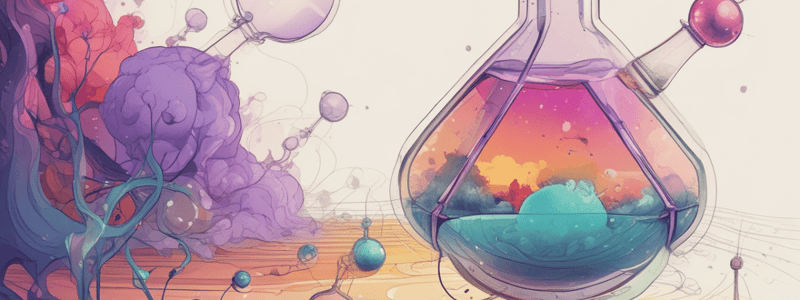Podcast
Questions and Answers
What is the reagent that dictates the amount of product formed in a reaction?
What is the reagent that dictates the amount of product formed in a reaction?
- Excess reagent
- Limiting reagent (correct)
- Catalyst
- Product
What is the purpose of finding the moles of reactants?
What is the purpose of finding the moles of reactants?
- To determine the catalyst
- To calculate the mass of product
- To determine the excess reagent
- To find the limiting reagent (correct)
What is the volume of water produced in the reaction if 0.14 moles of ethanol react?
What is the volume of water produced in the reaction if 0.14 moles of ethanol react?
- 33 L
- 22 L
- 15 L
- 11 L (correct)
What is the unit of molar ratio?
What is the unit of molar ratio?
What is the main reason why the actual yield of a reaction is often less than the theoretical yield?
What is the main reason why the actual yield of a reaction is often less than the theoretical yield?
What is the percentage yield of ethene if the actual yield is 8g and the theoretical yield is 12.18g?
What is the percentage yield of ethene if the actual yield is 8g and the theoretical yield is 12.18g?
What is the volume of ethane collected at room temperature if the percentage yield is 15% and the molar volume at room temperature is 24 L?
What is the volume of ethane collected at room temperature if the percentage yield is 15% and the molar volume at room temperature is 24 L?
What is the formula to calculate the percentage yield?
What is the formula to calculate the percentage yield?
What is the molar mass of ethanol (C₂H₅OH)?
What is the molar mass of ethanol (C₂H₅OH)?
What is the purpose of the balanced equation in the calculation of the percentage yield?
What is the purpose of the balanced equation in the calculation of the percentage yield?
Study Notes
Stoichiometry Calculations
- In some reactions, one of the reactants is added in excess, and the substance not present in excess is called the limiting reagent.
- The limiting reagent determines the amount of product formed.
Calculations with a Reactant in Excess
- Example: Copper and Sulphuric acid react as follows: Cu + H₂SO₄ → CuSO₄ + H₂
- Given a solution containing 78.4g of Sulphuric acid and 53.975g of Copper, Copper is present in excess.
- The limiting reagent is Sulphuric acid, and 0.8 moles of Sulphuric acid react, forming 0.8 moles of CuSO₄.
Calculating the Mass of Product Formed
- Moles of reactant × Molar Ratio × Molar Mass of product = mass of product
- Example: 0.8 moles of H₂SO₄ × 1:1 × 159.5 g/mol = 127.6 g of CuSO₄
Calculating the Volume of Gas Formed
- Moles of reactant × Molar Volume at room temperature = volume of gas
- Example: 0.8 moles of H₂SO₄ × 24 L/mol = 19.2 L of H₂
Identifying the Limiting Reagent
- Example: Ethanol (CH₃COOH) is prepared by the oxidation of ethanol as follows: 3CH₃COOH + 2Cr₂O₇ + 16H⁺ → 3CH₃COOH + 4Cr + 11H₂O
- Given 8.0 cm³ of ethanol (density = 0.8 g/cm³) and 29.8g of Sodium dichromate, Ethanol is the limiting reagent.
Percentage Yield
- The percentage yield of a reaction is the ratio of the actual yield to the theoretical yield, expressed as a percentage.
- Factors that can affect the percentage yield:
- Reversible reactions occurring
- Further reactions occurring (e.g., between a product and a reactant)
- Losses during purification of the product
Calculating Percentage Yield
- Example: Dehydration of ethanol to form ethene: C₂H₅OH → C₂H₄ + H₂O
- Given 20g of ethanol, the theoretical yield is 12.18g, and the actual yield is 8g, the percentage yield is 65.68%.
Calculating the Volume of Gas Collected
- Example: The same experiment as Q1 was performed, and 2.3 cm³ of ethanol was reacted, giving a yield of 15%.
- The theoretical volume of ethene collected is 0.96 L, and the actual volume can be calculated using the percentage yield.
Studying That Suits You
Use AI to generate personalized quizzes and flashcards to suit your learning preferences.
Description
Determine the limiting reagent and excess reactant in a chemical reaction between copper and sulphuric acid. Calculate the amount of product formed.




